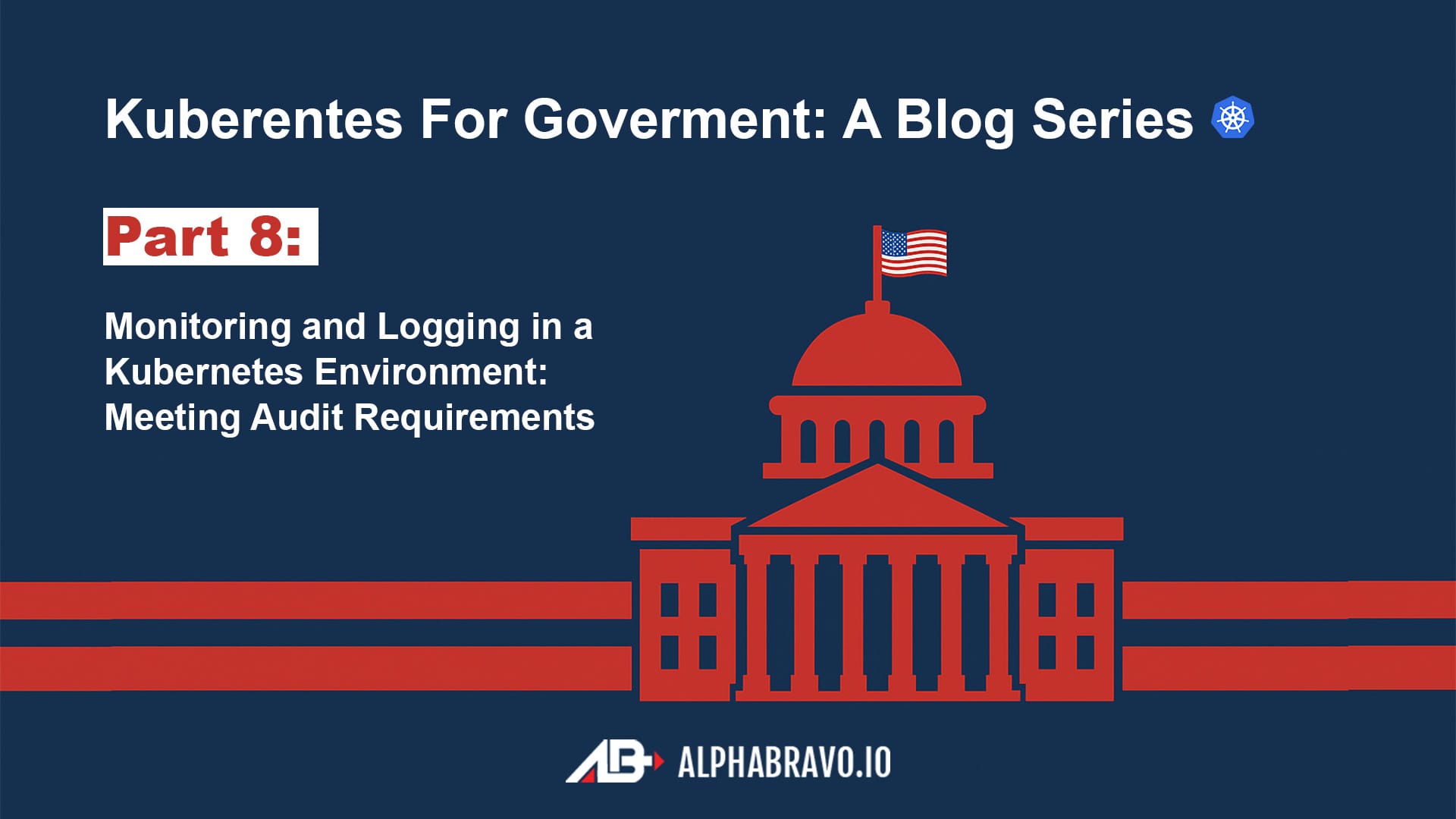Monitoring and Logging in a Kubernetes Environment: Meeting Audit Requirements (Part 8)
Visibility is Security. Meet audit requirements with Kubernetes-native monitoring and logging that won’t let threats slip through the cracks.

In our journey through the Kubernetes government compliance landscape, we've covered everything from baseline security controls to identity management and securing container supply chains. Now we arrive at what might seem like the most mundane yet surprisingly complex aspect: monitoring and logging. Trust me, there's nothing federal auditors love more than a well-maintained, comprehensive, and tamper-proof log. It's like catnip for compliance officers.
The Federal Logging Labyrinth
Before diving into the technical implementation, let's understand the regulatory landscape we're navigating. The Risk Management Framework (RMF) from NIST SP 800-53 Revision 5 contains a treasure trove of controls related to logging, including the generation, review, protection, and retention of audit records (as outlined in the AU family of controls). FedRAMP builds upon these requirements, demanding comprehensive and centralized logging capabilities that capture everything from user authentication to system configuration changes.
The Department of Defense takes this even further. According to DoD Inspector General audit reports, systems must "obtain an authority to operate in accordance with DoD policy before their use" and "immediately identify and implement security controls to minimize risk". This applies to all IT systems, including Kubernetes clusters, which must comply with these cybersecurity regulations to guard against vulnerabilities like unauthorized access or digital thread hacking.
If paperwork was the bane of government operations in the pre-digital era, logs are its modern equivalent-except now instead of filing cabinets, we have terabytes of storage filled with JSON entries detailing every API call, pod creation, and configuration change. The difference? These digital records can actually save your deployment when something goes catastrophically wrong. Or when an auditor comes knocking.
Kubernetes Logging: Drinking from a Fire Hose
Kubernetes produces logs at various levels, and understanding this architecture is crucial before implementing any solution:
- Container logs: Applications inside containers typically write to stdout and stderr, which the kubelet collects and writes to files on the node.
- System component logs: Control plane components like kube-apiserver, kube-scheduler, and kube-controller-manager generate their own logs.
- Node-level logs: Kubelet and container runtime logs provide insights into node operations.
- Event logs: Kubernetes events provide information about cluster state changes.
- Audit logs: Special logs that record API server requests, providing a security-relevant chronological set of records.
If you've been running a production Kubernetes cluster without proper log aggregation, you know the feeling of trying to diagnose an issue by SSH-ing into multiple nodes, piecing together container logs, and wishing you had invested in a proper logging solution months ago. It's like trying to drink from a fire hose while the building is actually on fire.
Audit Logging: The Federal Way
Kubernetes audit logging is where compliance meets reality. According to the Kubernetes documentation, auditing provides a security-relevant, chronological set of records documenting the sequence of actions in a cluster. These audit records are generated for each request on each stage of its execution by the kube-apiserver.
To implement audit logging that meets federal requirements, you'll need to configure the API server with an audit policy file. This policy defines which events should be recorded and what data they should include. The audit policy can filter based on different criteria and specify the level of detail to include: None, Metadata, Request, or RequestResponse.
The stages of audit logging in Kubernetes include:
- RequestReceived: Events generated as soon as the audit handler receives the request
- ResponseStarted: Once the response headers are sent but before the response body
- ResponseComplete: After the response body has been completed
- Panic: Events generated when a panic occurred
For federal compliance, you'll typically want to capture events at the RequestResponse level for critical operations like authentication, authorization, resource creation/deletion, and privileged operations. Less sensitive operations can be captured at the Metadata level to balance performance and storage concerns.
Configuring the kube-apiserver with the right audit policy is a joy that ranks somewhere between root canal surgery and filing taxes-necessary, occasionally painful, but ultimately rewarding when you pass that audit with flying colors.
Prometheus and Grafana: Your Monitoring Dynamic Duo
While logs tell you what happened, metrics tell you how well your system is performing. For Kubernetes monitoring that satisfies federal requirements, Prometheus has become the de facto standard.
Prometheus works by collecting metrics from configured targets at specified intervals, evaluating rule expressions, displaying results, and triggering alerts when conditions are observed. It's particularly well-suited for Kubernetes environments because:
- It uses a pull model, which works well with dynamic container environments
- It stores metrics as time series data with metadata
- It has powerful query capabilities through PromQL
- It operates even when other parts of the infrastructure are down
To implement Prometheus in a compliance-focused environment, you'll need to consider:
- Running Prometheus as a StatefulSet for persistent storage
- Implementing proper access controls to the Prometheus API
- Configuring retention policies that align with federal requirements
- Setting up alerting for security-relevant events
Grafana complements Prometheus by providing visualization capabilities that transform raw metrics into actionable insights. A well-designed Grafana dashboard for Kubernetes can display cluster state, workload performance, and security events in a format that both engineers and auditors can appreciate.
Looking at a fully configured Grafana dashboard for Kubernetes security monitoring is like sitting in the cockpit of an F-35-there are gauges and indicators everywhere, and while you might not need all of them all the time, you're certainly glad they're there when alarms start flashing.
The Elastic Stack: Logs, Logs Everywhere
For comprehensive logging that satisfies federal requirements, the Elastic Stack (formerly known as the ELK stack) provides a robust solution. The stack consists of:
- Elasticsearch: For storing and indexing logs
- Logstash: For log processing and transformation
- Kibana: For visualization and analysis
- Beats: Lightweight shippers for sending data to Elasticsearch or Logstash
In a Kubernetes environment, you can deploy Filebeat as a DaemonSet to collect container logs from each node. This approach ensures that even if a pod is rescheduled or a node fails, the logs are still collected and forwarded to your central logging system.
The Elastic Stack can be configured to meet FedRAMP and RMF requirements by:
- Implementing proper authentication and authorization
- Encrypting data in transit and at rest
- Setting up index lifecycle management for log retention
- Creating dashboards and alerts for security events
Of course, implementing Elasticsearch in a production environment comes with its own set of challenges. It's both a blessing for its powerful search capabilities and a curse for operations teams trying to plan storage capacity. "How much disk space do we need for logs?" is a question that invariably leads to the answer: "More than you think."
Tamper-Proof Logs: Because Trust Is Not Enough
For federal environments, particularly DoD ones, ensuring logs cannot be tampered with is a critical requirement. After all, what good is an audit trail if someone can modify it to cover their tracks?
Implementing tamper-proof logging in Kubernetes requires several layers of protection:
-
Immutable infrastructure: Container images and deployments should be immutable, with changes requiring new deployments rather than modifications.
-
Log forwarding: Forward logs to external systems as soon as they're generated, minimizing the window for tampering.
-
Digital signatures: Implement digital signing of logs to detect unauthorized modifications, similar to approaches used by India and Estonia for their digital identity systems.
-
Blockchain or append-only data structures: For the highest level of security, consider using blockchain technology or append-only data structures to make logs immutable.
-
Separation of duties: Ensure that those generating logs don't have the ability to modify them.
Remember, in security, healthy paranoia is not just an asset-it's practically a job requirement. The person who says "nobody would go to all that trouble to cover their tracks" has clearly never read a data breach post-mortem.
Best Practices for Federal Compliance
Based on lessons learned from successfully implementing secure logging in government environments, here are best practices to keep in mind:
-
Centralize log collection: Establish a central logging solution that aggregates logs from all components of your Kubernetes cluster.
-
Implement log rotation: Configure log rotation to manage disk space while maintaining the required retention period for compliance.
-
Use structured logging: Encourage application teams to use structured logging formats like JSON to make parsing and analysis easier.
-
Include contextual information: Ensure logs contain sufficient context, including timestamps, source information, and correlation IDs.
-
Monitor log integrity: Regularly verify that logging is functioning correctly and that logs haven't been tampered with.
-
Automate log analysis: Implement automated analysis to detect potential security incidents and compliance violations.
-
Regular log reviews: Schedule periodic reviews of logs as required by federal standards, and document these reviews.
-
Establish clear policies: Document your logging policies, including what is logged, how long logs are retained, and who has access to them.
The volume of best practices documents for federal IT would probably rival the size of the tax code at this point. The difference is that following these logging best practices might actually save you from a security incident, whereas the tax code... well, that just gives you a headache.
Looking Ahead: From Logging to Patching
As we wrap up our exploration of monitoring and logging, it's worth noting that these capabilities form the foundation for other critical security functions. In our next installment, we'll tackle "Managing Updates and Patching in a Secure Kubernetes Cluster," where we'll see how the monitoring and logging infrastructure we've just built becomes essential for tracking patch compliance, monitoring for vulnerabilities, and ensuring that no security update falls through the cracks.
After all, knowing what's happening in your cluster is only half the battle. Taking action based on that information-particularly when it comes to applying critical security patches-is where the rubber meets the road in federal compliance.
So keep those logs flowing, those metrics reporting, and those dashboards glowing-they're not just satisfying audit requirements, they're providing the visibility you need to ensure your Kubernetes environment remains secure in the ever-evolving threat landscape of federal IT.
And remember, even the most sophisticated monitoring setup can't protect you if you're not actually looking at it. As a wise system administrator once said, "The most expensive monitoring system in the world is the one that nobody checks until after the breach."

